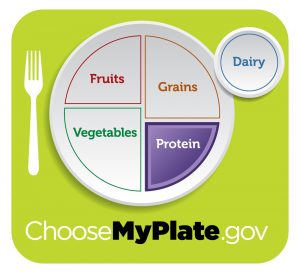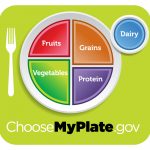Bulletin #4394, Eating for Health with MyPlate: Protein Foods
 Prepared by Extension Educator Kate Yerxa and Extension Specialist Leslie Forstadt, University of Maine Cooperative Extension. Reviewed by Extension Educators Alan Majka and Jane Conroy, University of Maine Cooperative Extension.
Prepared by Extension Educator Kate Yerxa and Extension Specialist Leslie Forstadt, University of Maine Cooperative Extension. Reviewed by Extension Educators Alan Majka and Jane Conroy, University of Maine Cooperative Extension.
For information about UMaine Extension programs and resources, visit extension.umaine.edu.
Find more of our publications and books at extension.umaine.edu/publications/.
Like most Americans, Mainers eat too much fat, sugar, sodium, and refined grains. These Eating for Health with MyPlate fact sheets can start you down the path to good health. Each one is about a different part of the 2020-2025 Dietary Guidelines for Americans and MyPlate healthy eating guidelines. You can learn what each part is, why it’s important, and how it matters to you and to your family. The MyPlate food groups are Grains, Vegetables, Fruits, Dairy, and Protein. This fact sheet explains the Dairy Group.
Which foods are in the Protein Foods Group?
Meat, fish, poultry, and eggs are part of the Protein Foods Group. So are nuts, seeds, and dry beans and peas like kidney beans, pinto beans, lima beans, black-eyed peas, and lentils. Choose lean and low-fat meats. Foods like fish, nuts, and seeds contain healthy fats. They are great foods to choose from this food group.
How much of this food group should adults eat?
The amount of protein foods needed each day is different for everyone. The average adult needs about 2,000 calories a day. In a 2,000 calorie diet, you need 5 1/2 ounces of protein foods a day. One ounce of protein foods is equal to
- 1 ounce of cooked meat, fish, or poultry ( a 3-ounce portion is the size of a deck of cards)
- 1/4 cup cooked dry beans, peas or lentils
- 1 egg
- 1 Tablespoon of peanut butter or almond butter
- 1/2 ounce of nuts or seeds
- 1/8 cup tofu (1/4 cup equals 2 ounces)
- 2 Tablespoons of hummus
Why protein foods?
The foods in the Protein Foods Group give you the building blocks you need for muscles and blood. Be careful: some protein foods are very high in unhealthy fat and calories. Don’t serve processed meats like hot dogs, sausage, bologna, and bacon too often. Instead, eat more dry beans and peas, seafood, lean cuts of poultry, nuts, and seeds. Soy foods, like tofu or soy burgers, are good, too.
How to include healthy protein foods in your diet
- Use dry beans or peas as the main protein source at a meal. Some ideas are chili, bean soups, bean quesadillas or enchiladas, baked beans, or hummus.
- Chose nuts as a snack. You can also sprinkle them on salads.
- Try serving different types of seafood in place of animal protein foods.
- If you buy fattier cuts of meat, trim away all of the fat. Remove skin from poultry before seasoning and cooking.
Kids and protein foods
- Make your own trail mix! For a healthy snack for older children, mix 3 different kinds of nuts together, and add raisins. Your child can help put 1/4 cup of the mix into snack bags. Pack bags ahead of time to have snacks ready for the week.
- Your child may not like new foods. Try serving a new food with something they like. If you are trying baked chicken for the first time, serve it with broccoli, if your child has eaten broccoli before.
- At the store, see how many kinds of dry beans and peas your child can find. There are more than 10 kinds of dry beans and peas. They are sold dry as well as canned.
- Kids can measure dry beans using a measuring cup. Have them pour the beans into a bowl before you add water for soaking.
- Place some dried beans or peas between some damp paper towels. Watch them sprout!
How to build a healthy plate
Balance calories
- Enjoy your food, but eat less.
- Avoid oversized portions.
Eat more of . . .
- Make half your plate fruits and vegetables.
- Make half your grains whole.
- Switch to fat-free or low-fat (1%) milk.
Eat less of . . .
- Compare sodium in foods like soup, bread, and frozen meals. Choose the foods with lower numbers.
- Drink water instead of sugary drinks.
Sources
U.S. Department of Agriculture and U.S. Department of Health and Human Services. Dietary Guidelines for Americans, 2020-2025. 9th Edition. December 2020. Available at DietaryGuidelines.gov.
U.S. Department of Agriculture. MyPlate website. 2021. https://www.myplate.gov
Information in this publication is provided purely for educational purposes. No responsibility is assumed for any problems associated with the use of products or services mentioned. No endorsement of products or companies is intended, nor is criticism of unnamed products or companies implied.
© 2011, 2017, 2021
Call 800.287.0274 (in Maine), or 207.581.3188, for information on publications and program offerings from University of Maine Cooperative Extension, or visit extension.umaine.edu.
The University of Maine is an EEO/AA employer, and does not discriminate on the grounds of race, color, religion, sex, sexual orientation, transgender status, gender expression, national origin, citizenship status, age, disability, genetic information or veteran’s status in employment, education, and all other programs and activities. The following person has been designated to handle inquiries regarding non-discrimination policies: Director of Equal Opportunity, 101 Boudreau Hall, University of Maine, Orono, ME 04469-5754, 207.581.1226, TTY 711 (Maine Relay System).


